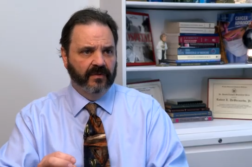CHICAGO, Ill. (Ivanhoe Newswire)—This year about 3,600 people will be diagnosed with bone cancer. Surgery, chemotherapy, and radiation are often treatment options. In the past, patients faced possible amputation. More on improvements in limb-sparing procedures that have saved a man’s leg not once, but twice.
Every step Steve Mateja takes is nothing short of a miracle. At age 19, Steve was diagnosed with bone cancer in his leg. Back in 1987, many patients would have faced amputation.
“I wasn’t one of those people that gave up easily. Even through chemotherapy and the original surgeries, I was always, ‘what do I need to do,’” Steve recalled.
At the time, orthopedic specialist Dr. Henry Finn used a device that allowed him to spare most of Steve’s leg.
“We chose to implant a custom-made device that included a cadaver bone that replaced his upper femur as well as his knee,” explained Dr. Finn, an orthopedic surgeon at Chicago Center for Orthopedics.
Steve recovered … went on to get married and have children. Two things he thought might never happen. Steve was doing well with the implant, until late last year when he fell and the implant broke. Thirty-three years later, Dr. Finn had another solution for Steve, an upgraded revision with an orthopedic salvage system, or OSS. Dr. Finn removed the old implant and reconstructed the limb with the OSS.
“The fit and feel of his original implant compared to the one he has now is like comparing a Yugo to a Ferrari,” Dr. Finn illustrated.
“I’ve seen him walk before, but not this way. It was smooth. It was like a normal person walking almost. And it brought tears to my eyes,” Cheli shared.
Cheli’s looking forward to the future when her husband can walk their daughter down the aisle. For now, Steve is happy to be here and still be on his feet.
“I think it’s the biggest gift anybody could give,” Steve expressed.
Dr. Finn says Steve’s original implant lasted 15 or 20 years longer than anticipated. Most of the early limb implants became worn or failed before 15 years. The new OSS device should last for the rest of Steve’s life.
Contributors to this news report include: Cyndy McGrath, Executive & Field Producer; Kirk Manson, Videographer; Roque Correa, Editor.
To receive a free weekly e-mail on Medical Breakthroughs from Ivanhoe, sign up at: http://www.ivanhoe.com/ftk
Sources:
MEDICAL BREAKTHROUGHS
RESEARCH SUMMARY
TOPIC: SAVING STEVE’S LEG … TWICE!
REPORT: MB #4877
BACKGROUND: Bone cancer occurs when unusual cells grow out of control in your bone and destroys normal bone tissue. It can start in your bone or spread to other parts of your body. Bone cancer is rare, and most tumors are found to be benign, but they may still weaken your bones and lead to broken bones or other problems. Primary bone cancer, also known as bone sarcoma, is a cancerous tumor that starts in your bone. Experts are unsure what causes it but feel genes may play a role. Cancer in your bones usually starts somewhere else in the body, and in this case, is called secondary bone cancer. Cancers that commonly spread to bone include breast cancer, prostate cancer, and lung cancer.
(Source: https://www.webmd.com/cancer/bone-tumors)
TREATING BONE CANCER: Surgery is the primary treatment for bone cancer and may also be needed for a biopsy of the cancer. The biopsy and the surgical treatment are separate operations, but it’s important that these procedures are planned together. The main goal of surgery is to remove all the cancer. If a few cancer cells are left behind, they can grow and make a new tumor. To ensure this doesn’t happen, surgeons remove the tumor plus some normal tissue around it. This is called wide excision. Sometimes the entire limb needs to be removed to remove all the cancer. This procedure is called an amputation. However, when a surgeon can remove the cancer without amputation, this is called limb-salvage or limb-sparing surgery. No matter which type of surgery is done, rehabilitation will be needed afterward.
NEW WAY TO RESTORE MOVEMENT: Cleveland Clinic researchers published findings in Science Translational Medicine on a new method of restoring natural movement sensation in patients with prosthetic arms. Paul Marasco, PhD, and his team have successfully engineered a sense of complex hand movements in patients with upper limb amputations. Considered a breakthrough, this may enhance the ability to control their prostheses, independently manage activities of daily living, and improve quality of life. The team used small, powerful robots to vibrate specific muscles to “turn on” patients’ sensation of movement. This allowed them to feel that their fingers and hands were moving and they were an integrated part of their own body. “Decades of research has shown that muscles need to sense movement to work properly. This system basically hacks the neural circuits behind that system,” said James W. Gnadt, Ph.D., program director at the National Institute of Neurological Disorders and Stroke.
FOR MORE INFORMATION ON THIS REPORT, PLEASE CONTACT:
MARYANN FIORENTINO
(773) 564-5880
If this story or any other Ivanhoe story has impacted your life or prompted you or someone you know to seek or change treatments, please let us know by contacting Marjorie Bekaert Thomas at mthomas@ivanhoe.com




